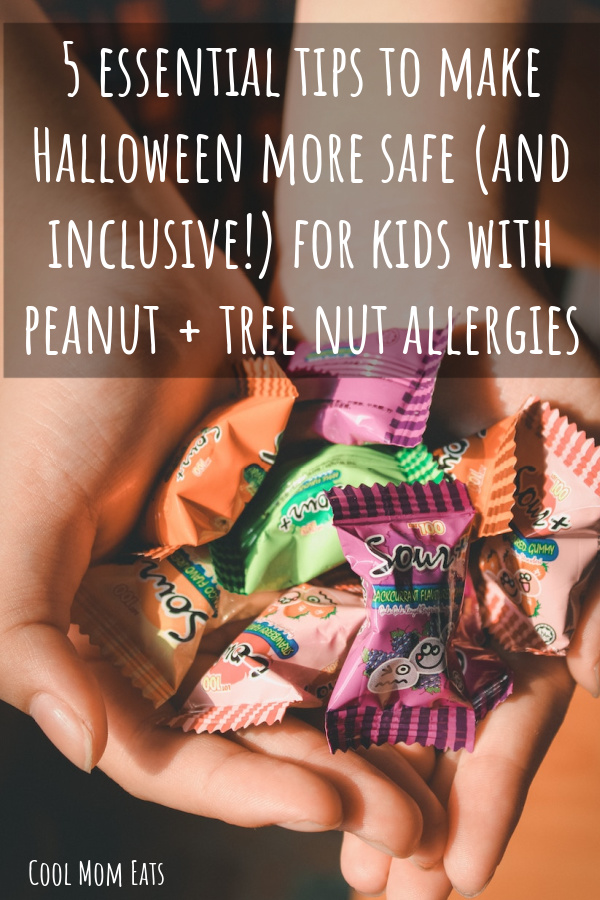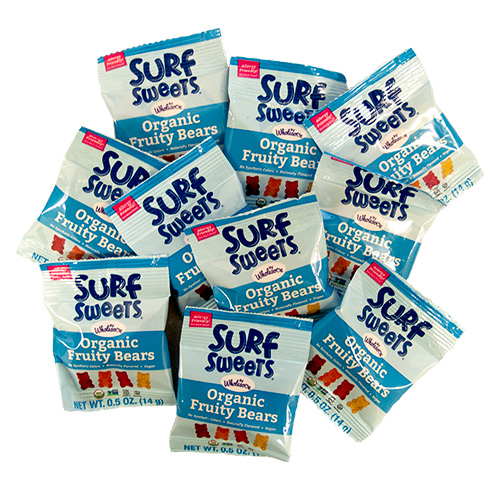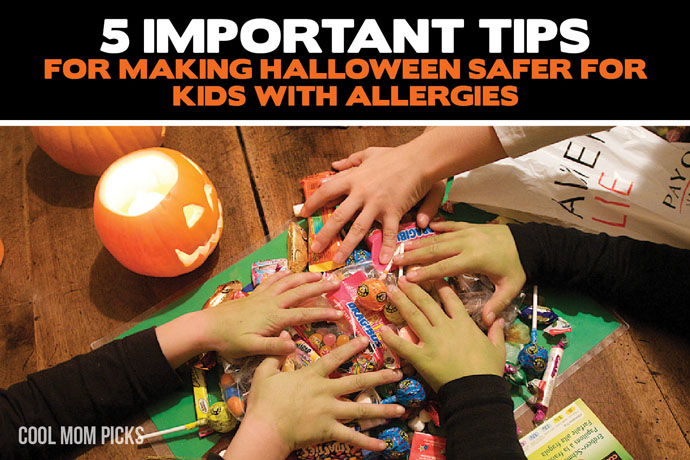We have always had an acute awareness about making Hallowen safe for kids with peanut and tree nut allergies. Especially because some of our own kids of our team members on Cool Mom Picks have grappled with peanut and tree nut allergies that range from mild to life-threatening.
If you don’t have children with allergies yourself, but want to make sure classroom friends, party guests, and neighborhood kids are in good hands with you on Halloween, these tips, gathered from our own “allergy mom” team members are really essential learning.
A few quick precautions and you won’t just be making Halloween safer for kids, you’ll be putting a whole lot of parents’ minds to rest on what can be an already scary day.
(Note: This post has been updated for 2022)
Related: 24 wonderful non-candy Halloween treats to give out

1. Read the labels. And look for ingredients besides “nuts.”
This may sound obvious, but before you hand out candy to a kid with an allergy to peanuts or tree nuts, check the ingredient list. FARE, A.K.A. FoodAllergy.org, offers great lists of ingredients that can trigger peanut allergies or tree nut allergies that may not jump out to you at first — ingredients like gianduja, lychee, mandelonas, marzipan and praline.
Oddly, coconut is classified as a tree nut by the FDA (sigh) but it’s a fruit, and many people with tree nut allergies can safely eat it.
It’s also important to know that “fun-size” candies may not be allergy-free, even if their full-size counterparts are, because the minis are made on a different production line. Don’t assume that one product from one brand that’s safe means they all are.
2. Don’t rely on labels alone!

A safe bet: the Halloween treats from Vermont Nut-Free
Keep in mind that FDA labeling will warn you if 8 major allergens, including tree nuts and peanuts, are intentional ingredients in a candy. However, that alone might not tell you whether a candy is safe. Not all companies follow FDA guidelines for labeling (like small businesses, for example, or a local bakery) and — get this — the FDA does not require companies to label for accidental ingredients.
That means all of those “may contain peanuts” or “manufactured in a facility that also processes tree nuts” warnings are not required by law.
Know this: The companies using warning labels are doing so voluntarily.
However this distinction can be essential to kids with severe allergies. So it’s best to find out whether a particular candy is truly nut-free. Before you buy, check with the allergic kid’s parents, call the company, check a trusted safe candy list, or buy from an allergy-safe candy maker.
Which brings us to…
3. Stick with trusted, allergy-safe brands, like these.

We’ve got some helpful post that list trusted, nut-free candies and treats. You can also visit Natural Candy Store, a shop we’ve liked for a while; they offer an entire category for allergen-free candy (focusing on 6 of the 8 most common food allergens).
Mainstream Halloween Candy Brands
– Twizzlers
– Junior Mints
– York Peppermint Patties
– Starburst
– Rolos
– Haribo Gummi Candies
– Tootsie Pops and Tootsie Rolls
– Hershey’s plain chocolate kisses
– Jolly Ranchers
– Skittles
– Whoppers
– SweeTarts
– Sour Patch Kids
– Dum Dums
– Dots
– Jelly Belly
– Sugar Babies
– Charleston Chews

Candy Brands Created with Allergies in Mind:
– Divvies
– Yum Earth
– Vermont Nut-Free
– No Whey Foods
– Enjoy Life
– Surf Sweets (makers of the gummies, shown here)
– Sun Cups
For more reassurance, visit Snack Safely which is a comprehensive website created by the parents of a child with multiple food allergies, and they offer an updated list of peanut-free, tree-nut-free and egg-free candies for Halloween each year.
4. Put out a teal pumpkin, and create separate bowls for trick-or-treaters
 Brilliant “cross-stitch’ teal pumpkin DIY via U Create for Eighteen25
Brilliant “cross-stitch’ teal pumpkin DIY via U Create for Eighteen25
If you’re not prepared to give up your Reese’s cups, here’s a smart idea: More and more we’re noticing considerate neighbors with two bowls out. One is labeled “candy with nuts,” and one labeled “tree nut-free.”
Just make sure if you do this that you’re careful to keep the candies totally separate before you put them in the bowls, to avoid any mix-ups.
And of course, you can mark your home with a teal pumpkin. Since 2014, this has been an initiative of Food Allergy Research and Education (FARE) to help trick-or-treaters quickly identify homes that are looking out for their safety with the treats they’ve chosen.
Related: 8 cool ways to decorate your teal pumpkin
5. Skip candy altogether, and make it fun for everyone!

Before you call us Halloween scrooges, we’re not talking apples or toothbrushes.
We’ve noticed that when our kids get to choose from a bag filled with candy, glo-sticks. temporary tattoos, orange slime and plastic spider rings, they more often than not go for the non-edible stuff. Like how cool are these temporary Halloween tattoos from Tattly above?
Check out our roundup of 24 cool non-candy Halloween treat ideas that you can buy or DIY, and you just might find they give you the reputation as the best place to trick-or-treat on your block.
Top Photo: david roessli via Creative Commons





